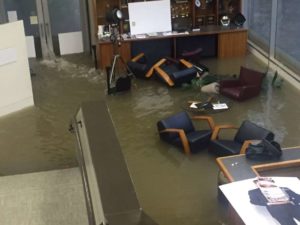HVAC System Repair and Maintenance Crucial after Hurricane Flooding
 For the first time in recorded history, the U.S. was slammed with back-to-back Category 4 hurricanes — Harvey and Irma — from the Atlantic. Many people in Texas and Florida continue to battle and hopefully recover from flooded streets, scattered debris, damaged homes, and inoperable buildings. The economic costs associated with this tag team of natural disasters in the U.S. are expected to be $290 billion.
For the first time in recorded history, the U.S. was slammed with back-to-back Category 4 hurricanes — Harvey and Irma — from the Atlantic. Many people in Texas and Florida continue to battle and hopefully recover from flooded streets, scattered debris, damaged homes, and inoperable buildings. The economic costs associated with this tag team of natural disasters in the U.S. are expected to be $290 billion.
Mold and HVAC Systems
Part of that recovery process will be to assess the extent of the water damage. In the hot and humid climates of Texas and Florida mold growth is the biggest concern.
Mold and mildew pose real threats to flooded buildings. The stagnant standing water presents the perfect environment for bacteria growth, making any porous materials susceptible.
Typically, mold grows on floors and walls, but flooded HVAC systems can also pose a real health threat if mold is allowed to grow. Ductwork and insulation that has mold growth can pose a health threat to the entire building if the HVAC system is running because mold spores can be carried through ducts and distributed throughout the building.
HVAC System Cleaning
Proper cleaning of HVAC systems after a flood is imperative to the health of building occupants. The Centers for Disease Control and Prevention recommends that you remove all flood-contaminated insulation and materials associated with the HVAC system and discard them.
Then you should clean the interior of the flooded system with a HEPA vacuum to remove the dirt and debris as well as microorganisms that typical industrial vacuums may not be able to pick up. After the HVAC system is cleaned it also needs to be thoroughly disinfected to prevent the growth of bacteria and microorganisms.
The aftermaths of Hurricane Harvey and Hurricane Irma will likely be felt for years while communities work to clean up and rebuild their homes and businesses. Prioritizing HVAC system cleaning is imperative to protect the health of building occupants during this time. Using a good HEPA vacuum to get rid of spores and a mold controlling cleaner are good ways to stop bacteria from growing and recurring.
Check out these other resources for information on HVAC mold prevention and cleaning:

